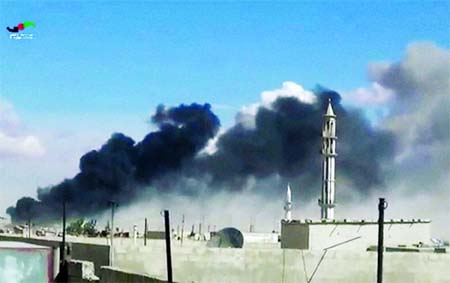
The Guardian :
Russia has bombed targets in north-west Syria for a second day, as the Kremlin said it was going after a list of well known militant organisations and not just Islamic State.
The Russian defence ministry said planes hit 12 Isis targets, including a command centre and two arms depots, though the areas where it said the strikes took place are not held by Isis.
Activists reported a number of strikes in the country’s north and centre, including strikes in the province of Hama which they said hit locations controlled by the US-backed rebel group, Tajamu Alezzah.
A spokesman for the Syrian civil defence said a strike also hit Jisr al-Shughour in Idlib province.
“They targeted the northern neighbourhood of the town, which only houses civilians, but there are very few people there because of repeated airstrikes,” the spokesman said.
US accuses Russia of ‘throwing gasoline on fire’ of Syrian civil war
Read more
Al Mayadeen, a Lebanese pro-Assad channel, separately reported that Russian aircraft had launched 30 fresh airstrikes against Jaysh al-Fateh, a powerful rebel coalition that includes Ahrar al-Sham and the al-Qaida affiliated al-Nusra Front.
Jaysh al-Fateh conquered much of north-west Syria in a major offensive this spring, including Jisr al-Shughour, ousting the Assad regime from the area and inching closer to its coastal stronghold of Latakia.
Activists in Homs also claimed that a Russian airstrike targeted a road near Talbiseh, a village that had been hit the day before.
In a dramatic escalation of the conflict, Russia launched a series of airstrikes on Wednesday that it had said were aimed at Isis terrorists but which mainly appeared to hit less extreme groups fighting Bashar al-Assad’s regime.
Syrian civil defence volunteers put the total civilian death toll from Wednesday’s strikes on Homs and Hama at 40, including eight children.
The volunteer group said thermobaric missiles were used and claimed that the missiles struck a public market, bread distribution point and administrative buildings in Homs, as well as civilian homes.
“We can’t believe an even more advanced military power has arrived in Syria to kill civilians,” said one civil defence volunteer in a statement issued by his organisation.
Syrian rebels launched attacks in northern Homs against Assad regime troops and pro-government civilian neighbourhoods using Grad rockets in what they said was retaliation for Russian airstrikes.
Videos posted by a conservative rebel coalition in northern Homs showed rebel fighters launching rockets and artillery.
Moscow had insisted that it was only targeting Isis militants in Syria, but on Thursday the line appeared to change, with a spokesman for Vladimir Putin saying that Russia was going after a list of groups in addition to Isis.
“These organisations are well known and the targets are chosen in coordination with the armed forces of Syria,” the spokesman said, without giving names.
Earlier, Sergei Lavrov, Russia’s foreign minister, said “the rumours that the target of these airstrikes was not Isis positions are unfounded”.
“Our targets are solely the positions of objects and equipment belonging to the armed terrorist group Isil [Isis],” Russia Today quoted Lavrov as saying.
Lavrov said Moscow had asked American officials to back up their accusations of Russia not targeting Isis with firm evidence. “They expressed doubt, arguing that there is evidence, which we asked [them] to show us, because we stand by our targets,” Lavrov said.
“Talk began that civilians were hurt by airstrikes. We have no such data,” he said. “We carefully make sure that these target strikes are precise.”
The US defence secretary, Ashton Carter, described Wednesday’s strikes as “illogical” and “doomed to fail”, telling reporters: “It does appear that they [the Russian airstrikes] were in areas where there were not Isil forces and this is precisely one of the problems with this approach.”
John Kerry, the US secretary of state, suggested he was prepared to welcome Russian military action in Syria only if it was directed against Isis. Appearing alongside Lavrov after their UN meeting, he said: “It is one thing obviously to be targeting Isil. We’re concerned, obviously, that is not what is happening.”
Kerry and Lavrov agreed that Russian and US military commanders would set up “deconfliction” talks to try to ensure their air forces did not inadvertently clash while they conducted overlapping air campaigns.
Lavrov said Russian and US officials would soon “get in touch and establish channels of communications to avoid any unintended incidents”.
The US was informed of Russia’s plans to launch strikes on Syria an hour before they occurred. The Department of State spokesman John Kirby said a Russian official in Baghdad had told US embassy personnel that Russian military aircraft would shortly begin flying anti-Isis missions in Syria. The official also asked that US aircraft avoid Syrian airspace during those missions.
Although the Obama administration defiantly vowed to continue its own bombing operations in Syria – and took umbrage at Russia’s insistence on Wednesday that the US ground its aircraft – the US military revealed on Thursday that it launched only a single airstrike in the wake of the Russian campaign. The strike, in Mar’a, north of Aleppo, destroyed two Isis excavators, according to the US Central Command.

